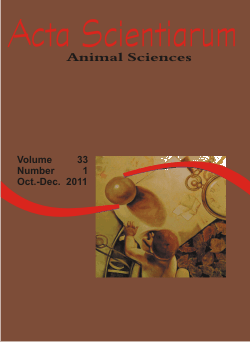<b>Yield and composition of pirarucu fillet in different weight classes</b> - doi: 10.4025/actascianimsci.v33i1.10843
Keywords:
Arapaima gigas, fat deposition, filleting
Abstract
The fillet yield and quantity of waste generated after processing are important for planning and evaluating the growth performance of species and systems of aquaculture production in Brazil. The pirarucu (Arapaima gigas) is among the species with desirable characteristics for intensive fish with high market value. The objective was to evaluate the performance of pirarucu fillet in different weight classes: 7.0 to 9.0 kg (group I), 11.0 to 13.0 kg (group II) and 14.0 to 17.0 kg (group III). The fillet yield presented no significant difference between groups. The composition showed significant differences (p < 0.05) for moisture (77.96 to 75.04%) and ash (2.21 to 2.46%), while values of lipid and protein were similar between classes evaluated. In assessing the fat percentage per serving (loin, belly and tail) there was higher fat deposition in the ventral part and in group III. Thus, it can be lessen the pirarucu with weight ranging from 7.0 to 9.0 kg, using shorter production cycles and obtaining better quality fillets by having a lower muscle percentage of lipids.Downloads
Download data is not yet available.
Published
2011-02-03
How to Cite
Fogaça, F. H. dos S., Oliveira, E. G. de, Carvalho, S. E. Q., & Santos, J. F. de S. (2011). <b>Yield and composition of pirarucu fillet in different weight classes</b> - doi: 10.4025/actascianimsci.v33i1.10843. Acta Scientiarum. Animal Sciences, 33(1), 95-99. https://doi.org/10.4025/actascianimsci.v33i1.10843
Issue
Section
Animal Production
DECLARATION OF ORIGINALITY AND COPYRIGHTS
- I Declare that current article is original and has not been submitted for publication, in part or in whole, to any other national or international journal.
The copyrights belong exclusively to the authors. Published content is licensed under Creative Commons Attribution 4.0 (CC BY 4.0) guidelines, which allows sharing (copy and distribution of the material in any medium or format) and adaptation (remix, transform, and build upon the material) for any purpose, even commercially, under the terms of attribution.
Read this link for further information on how to use CC BY 4.0 properly.
0.9
2019CiteScore
29th percentile
Powered by 








































